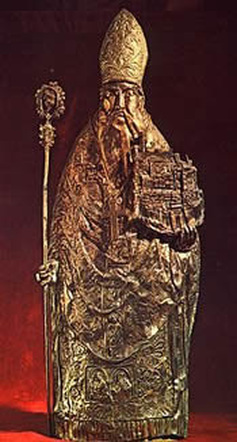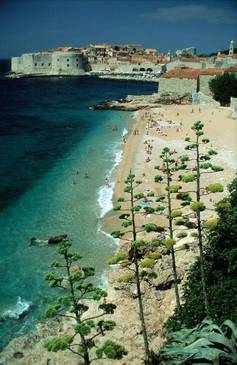Dubrovnik
Origins
Although the archeological evidence suggests that the cliff site of Dubrovnik was inhabited by the Iron Age the actual origin of Dubrovnik is steeped in mystery.
According to a passage written by the Bizantine Emperor, in the beginning of 7th ct. some inhabitants of Pitauru fled before the barbarian hordes and settled in what is today Dubrovnik. Another, more mythical account, states that a certain Radoslav the White, King of Bosnia, exiled to Rome after being overthrown by his son Ceslav in 458. When Ceslav died without the successor, ambassadors were sent to invite Radoslav to return. Radoslav accepted and on this return landed in Dubrovnik (Gruž, according the chronicle written by Nikola Ranjina) where he decided to stay. The earliest fortifications were to preserve the treasure and relics. St. Blaise, the Patron Saint
In 971 a Venetian army landed in Dubrovnik under pretenses of being en route to Levant. When St. Blase appeared at midnight to Don Stoico explaining the Venetians plan to seize Dubrovnik, the Don ran to the town authorities and these in turn promptly sent Venetians on their way (however, it was under their suzerainty from 1205 to 1358). St. Blase has been the Dubrovnik's patron saint ever since.
After the Fall of Rome
From the fall of Rome until the 9th
ct. Dubrovnik was ruled by
Bizantium.
The Mercantile Power
Utilizing the Balkans' and the
Adriatic trading routes Dubrovnik
grew into a mercantile power. Having
no military might, it relied on its
skillful diplomats to preserve its
freedom.
Croatian Athens
An unprecedented flourishing of arts
and literature followed in the 15th,
16th, and the 17th ct. earning
Dubrovnik the title of 'Croatian
Athens'.
The Great Quake
The great earthquake (Velika
Trešnja) struck Dubrovnik about 8am
on April 6, 1667. Many
people and much of the
property perished eitherby the quake
itself or in the fires it caused. It
was only with the greatest of
efforts and courage that a handful
of patricians restored the order in
the city.
The New Prosperity
During the Napoleonic years the
Republic enjoyed its short-lived
prosperity again.
The Ragusan Republic Abolished
At about 2 o'clock on January 29,
1808, a representative of Napoleonic
France, one Colonel Delort, entered
the Senate and delivered a brief
speech with which the Republic was
abolished.
After the Republic
The Congress of Vienna in 1915 gave Dubrovnik to Austria. In 1918 it was incorporated into Yugoslavia, the very same artificial state which in 1991, during Croatia's war for independence, brought much destruction to the people and the cultural heritage of this glorious city.
The City of Dubrovnik Today
The Pearl of Adriatic, Dubrovnik,
today stands as welcoming and as
beautiful as ever; its sturdy walls
bask in the Mediterranean sun, its
rooftops smile at the streets
bustling with locals and tourists
alike. . .
George Bernard Shaw once said if you wanted to see heaven on earth you had to come to Dubrovnik. And you were quite right, Berny. Quite right. |
Additional Sources
|


